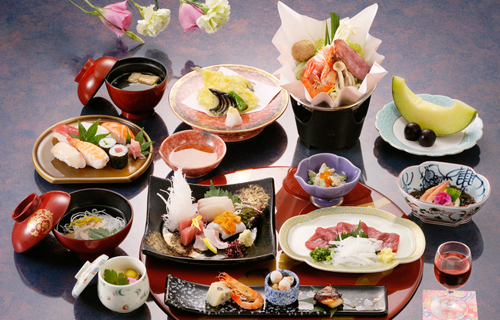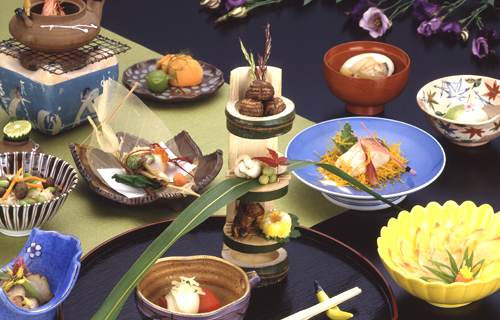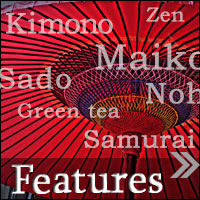Kaiseki Cuisine
Kaiseki Cuisine
Kaiseki cuisine is a kind of Japanese cuisine and synonym of aesthetic and sophisticated cuisine in Japan. There is no chance to eat Kaiseki cuisine in abroad countries.

This is a type of cuisine serves for the guest of tea ceremony. Its mind is to serve with everything what the host cans more than he/her limit.
Lately and some cases, the original meaning is little changed and the cuisine prepares with practical reason such as to support and maximize the tea taste.
Anyway, the origin came from Buddhism and tea ceremony. There are strict manners to enjoy Kaiseki cuisine and the manners are depends on the tea ceremony denomination and depends on the course, season and time.
For example, we’d like to explain a sample manners such as the followings.
The host
- Make the course only using the seasonal materials and it should be made the most of the materials opportunity.
- Use everything of the material and it should not through away any part of it.
- Combine sea food, food of mountain and food of land efficiently and it should not be overlapped.
- Broiled fish: you should start to eat from the left behind of the head. When you finished the left side of the fish, don’t turn it, remove the born and eat the right side with out removing the head.
The Gusest
- Sashimi or Sushi: Don’t solve Wasabi into the soy source. Put Wasabi to a side and dip into the soy source the other side. Be careful, dip just a little bit (about 1 cm). Please don’t make Sushi swimming in a Soy Source pool. The beautiful way to eat is finish the soy source when you finished all Sashimi. In the case of Sushi don’t use chopsticks, use your hand when you dip and eat. And fish side of Sushi put on your tongue and eats it.
- Stewed/simmered dishes: something hard to grave with chopsticks, stick one of the chopstick to grave it well. Etc ...
Origin
The name of “Kaiseki” cuisine has the origin of Buddhism Zen. Kaiseki means hold a stone. When a monk received a visitor, there was any food even the visitor had hungry. The monk tries to give a warm stone to put it to the stomach of the visitor to divert himself from the hunger. From this story of Zen, Kaiseki cuisine was named. As it is already explained, there are strict rules and manners. Before to go there we recommend you to ask or check the manner where you go. Maybe in the hotels helps you to learn even it’s a plated work, it’s better than nothing.

- Kyoto Cuisine
- Kyoto Cuisine
- Shojin Cuisine
- Tofu
- Umaki
- Atsuage
- Saikyo Yaki
- Kyoto Sweets
- Kyoto Sweets
- Kuzukiri
- Yatsuhashi
- Tsukemono (Picles)
- Tsukemono (Picles)
- Green Tea
- Green Tea




